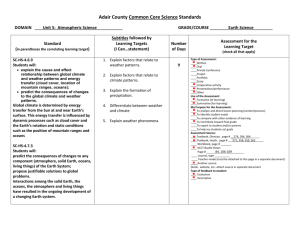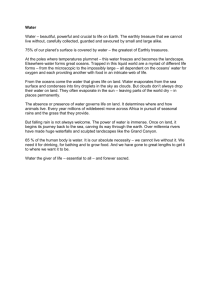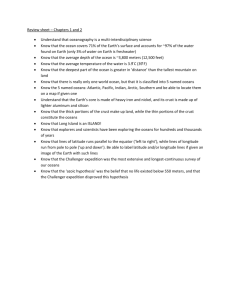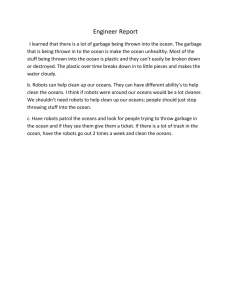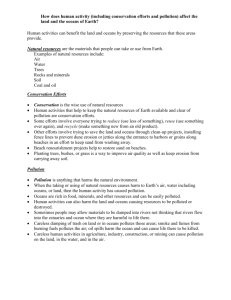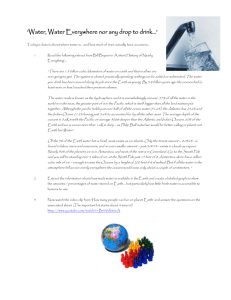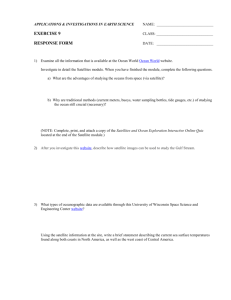The Oceans – Global Garbage - Canadian Geographic Education
advertisement
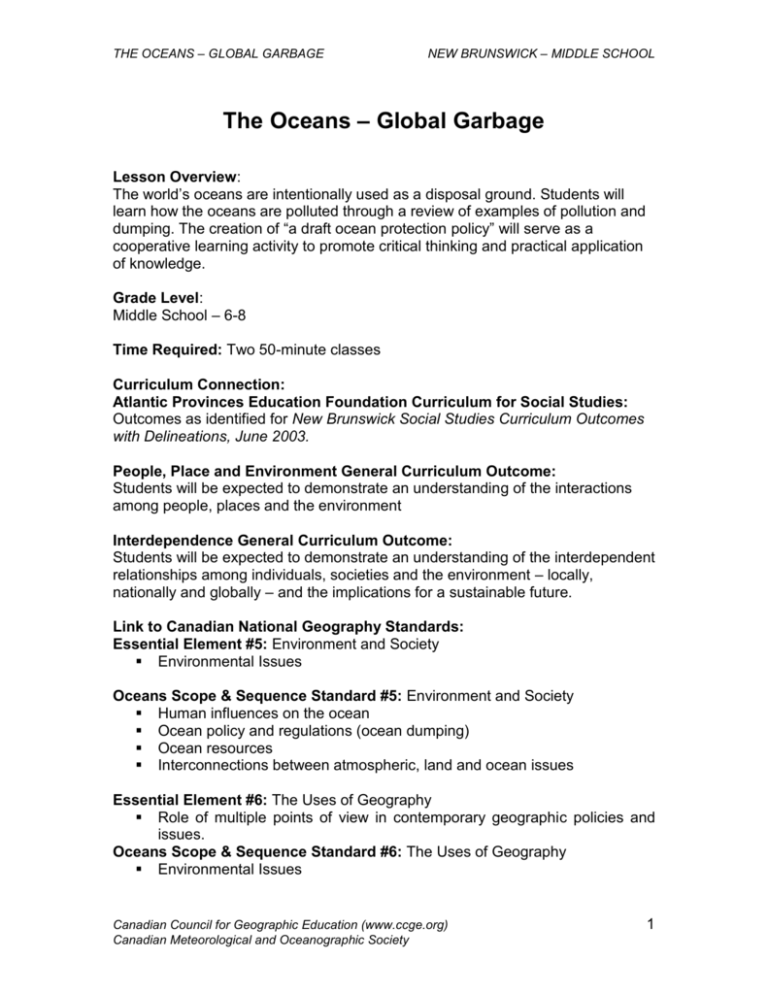
THE OCEANS – GLOBAL GARBAGE NEW BRUNSWICK – MIDDLE SCHOOL The Oceans – Global Garbage Lesson Overview: The world’s oceans are intentionally used as a disposal ground. Students will learn how the oceans are polluted through a review of examples of pollution and dumping. The creation of “a draft ocean protection policy” will serve as a cooperative learning activity to promote critical thinking and practical application of knowledge. Grade Level: Middle School – 6-8 Time Required: Two 50-minute classes Curriculum Connection: Atlantic Provinces Education Foundation Curriculum for Social Studies: Outcomes as identified for New Brunswick Social Studies Curriculum Outcomes with Delineations, June 2003. People, Place and Environment General Curriculum Outcome: Students will be expected to demonstrate an understanding of the interactions among people, places and the environment Interdependence General Curriculum Outcome: Students will be expected to demonstrate an understanding of the interdependent relationships among individuals, societies and the environment – locally, nationally and globally – and the implications for a sustainable future. Link to Canadian National Geography Standards: Essential Element #5: Environment and Society Environmental Issues Oceans Scope & Sequence Standard #5: Environment and Society Human influences on the ocean Ocean policy and regulations (ocean dumping) Ocean resources Interconnections between atmospheric, land and ocean issues Essential Element #6: The Uses of Geography Role of multiple points of view in contemporary geographic policies and issues. Oceans Scope & Sequence Standard #6: The Uses of Geography Environmental Issues Canadian Council for Geographic Education (www.ccge.org) Canadian Meteorological and Oceanographic Society 1 THE OCEANS – GLOBAL GARBAGE NEW BRUNSWICK – MIDDLE SCHOOL Geographic Skill #4: Analyzing Geographic Information Use statistics and other quantitative techniques to evaluate geographic information. Additional Resources: “The Oceans-Global Garbage” Fact Sheet Flip Chart Paper “The Oceans-Global Garbage” Table Handout. Main Objective: To understand the role of humans in how oceans have become polluted and think about ways to regulate or change that behaviour. Learning Outcomes: By the end of the lesson, students will be able to: Identify five sources of ocean pollution Understand how humans impact the ocean environment Understand the background behind policy that governs ocean pollution Know the impacts of disparity in the policies of different regions and how this disparity affects the Oceans System. Additional Reading: Gaia - An Atlas of Planet Management - Myers, Norman, Anchor; Updated edition, 1993 www.oceannet.ca Canadian Council for Geographic Education (www.ccge.org) Canadian Meteorological and Oceanographic Society 2 THE OCEANS – GLOBAL GARBAGE NEW BRUNSWICK – MIDDLE SCHOOL The Lesson: Lesson Development Introduction Teacher Activity Student Activity Guided discussion on the pollution in the oceans. How does it get there? What impacts does pollution have on humans? What impact does it have on animals and sea creatures? What relationship exists between land and ocean? Respond to teacher’s discussion. Discuss interconnectedness of the oceans. Students use the discussion and “Oceans” Fact Worksheet to record ideas based on three categories. An example of a closed system with Inputs (garbage), Processes (mixing, currents, etc) and Outputs (movement, deposition of garbage, sensitive areas etc.) Where does the pollution go? Discuss the idea that pollution takes long periods of time to break down but moves. Give appropriate examples from their own experiences or current events knowledge that give background to teacher questioning. Student groups must identify at least three pollutants. Examples are given on the worksheet. Groups complete the “Oceans” Pollutant Table worksheet. What is polluting our oceans? Discuss NIBMY – Not In My Backyard. What are the effects of the Pollution? How can pollution be tolerable in one place and deadly in another? What alternative is there to dumping/creating this pollutant? Refer to “Oceans” Fact Worksheet handout. Conclusion Students may reproduce this on flip chart paper or complete the worksheet handout. Discuss how oceans are protected, and that countries govern their oceans with ever-changing policies and laws. In groups of two, students create a draft policy that dictates how oceans should be protected. Lesson Extension: Students brainstorm alternatives to dumping in the oceans. Students present their ideas in two areas: Reducing the amount of garbage and pollution. Creating acceptable disposal practices. Assessment of Student Learning: Students are evaluated on three areas Presentation ideas Development and submission of draft policy. Matrix worksheet Canadian Council for Geographic Education (www.ccge.org) Canadian Meteorological and Oceanographic Society 3 THE OCEANS – GLOBAL GARBAGE NEW BRUNSWICK – MIDDLE SCHOOL The Oceans- Global Garbage: Fact Sheet 362,000,000 km2 or 71% of the surface of the globe is water. The oceans influence all life on earth. We actually know relatively little about the oceans. In our times, political and commercial decisions are made, which can destroy developments of billions of years, in just days, hours and minutes. Some may think that changes in one drop of water won't change the 1,300,000,000 km3 of water on earth. A human being also consists of billions of cells; the change in just one cell may be the beginning of a terminal illness. Coastline The total length of the world's coastlines is about 504,000 km, enough to circle the equator 12 times. Canada has the longest coastline of any country. The 1996 Canadian Encyclopedia gives the length as 243,797 km, including the major island coastlines. Population More than half the world’s population lives within a 100 km or 60 miles distance from the coast - this accounts for more than 2.7 billion people. Rapid urbanization will lead to more coastal mega cities containing 10 million or more people. By the end of the millennium, 13 out of 15 of the world’s largest cities will be located on or near the coast. Growing population in coastal areas leads to more marine pollution and distribution of coastal habitats. Some 6.5 million tons (6,500,000,000 kilo) of litter finds its way into the sea each year. Tourism In 1999, international tourism made $290,000,000. Most of these proceeds came from coastal areas. Food Production The sea provides the biggest source of wild or domestic protein in the world. Each year some 70 to 75 million tonnes of fish are caught in the ocean. Of this amount, around 29 million tonnes is for human consumption. The global fish production exceeds that of cattle, sheep, poultry or eggs. Canadian Council for Geographic Education (www.ccge.org) Canadian Meteorological and Oceanographic Society 4 THE OCEANS – GLOBAL GARBAGE NEW BRUNSWICK – MIDDLE SCHOOL The largest numbers of fish are located in the Southern Hemisphere due to the fact that man does not largely impact these waters. Habitat The oceans contain 95% of the habitat space on the planet. Pollutants Sewage, pulp mill wastes, fertilizers, soaps, detergents, radioactive wastes, synthetic fibers, plastics, oils, tars, greases and insecticides are all pollutants man has placed in our Earth's oceans. Hot and cold water from factories and silt from dredging can also be considered pollutants because they are abnormal to the surrounding water conditions. Air Pollution Air pollution is responsible for 33% of the toxic contaminants that end up in oceans and coastal waters. About 44% of the toxic contaminants come from rivers and streams. Animal Deaths In one year, over 100 million sharks are killed, most of them solely for their fins. In one year, one million seabirds and 100,000 marine mammals and sea turtles suffer cruel deaths from entanglement or suffocation in plastics. Annually, about 600 miles of commercial fishing nets break loose, float freely and become a curtain of death. Carbon Dioxide Absorption Oceans absorb between 30% and 50% of the carbon dioxide produced by burning fossil fuel. Carbon dioxide is transported downwards by plankton. Any change in the temperature of the ocean water influences the ability of plankton to take up carbon dioxide. This has consequences for the ecosystem because plankton forms the base of the food web. Reefs Over 60% of the world's coral reefs are threatened as a result of pollution, sedimentation and bleaching due to rising water temperatures caused by global warming. Global Coral Monitoring Network (GCRMN) states that currently 27% of all coral reefs worldwide have disappeared and around 2050 only 30% will be left. Garbage/Contamination In one year, three times as much rubbish is dumped into the world's oceans as the weight of fish caught. Canadian Council for Geographic Education (www.ccge.org) Canadian Meteorological and Oceanographic Society 5 THE OCEANS – GLOBAL GARBAGE NEW BRUNSWICK – MIDDLE SCHOOL A single quart of motor oil can contaminate up to 2 million gallons of drinking water. Marine Salvage In the five-year period from 1994-98, marine salvagers recovered 6,956,922 tonnes of oil, 428,728 tonnes of hazardous chemicals and 206,130 of other pollutants. Oil spills In 1989, the Exxon Valdez ran aground off the coast of Alaska and 38,800 metric tonnes of oil was spilled. It was the worst tanker spill in U.S. history, but in terms of all time oil spills, it doesn't even rank amongst the top 20. About one tenth of one percent of oil shipped each year is spilled at sea. That amounts to 2,200,000 tonnes annually. Canadian Council for Geographic Education (www.ccge.org) Canadian Meteorological and Oceanographic Society 6 THE OCEANS – GLOBAL GARBAGE NEW BRUNSWICK – MIDDLE SCHOOL The Oceans-Global Garbage: Table Pollutants of our oceans Effects of the pollutants Alternatives to dumping/creating this pollutant. Canadian Council for Geographic Education (www.ccge.org) Canadian Meteorological and Oceanographic Society 7

